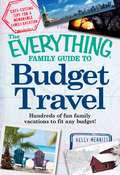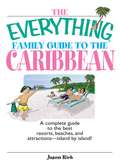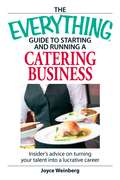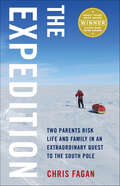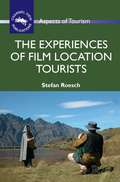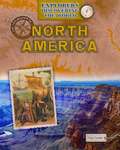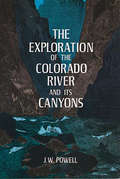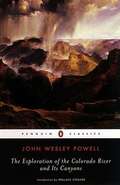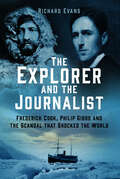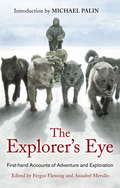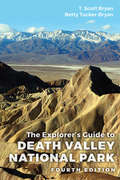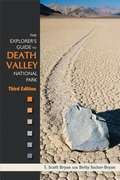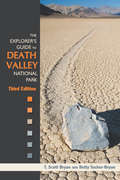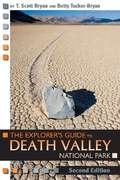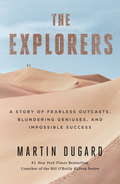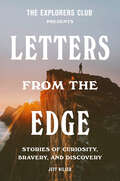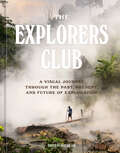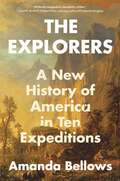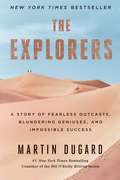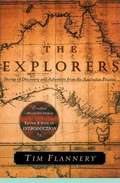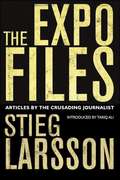- Table View
- List View
The Everything® Family Guide To The Disneyland® Resort, California Adventure ®, Universal Studios ®, And The Anaheim Area
by Betsy MalloyIf your idea of the perfect vacation involves sunny days, thrilling rides, and movie magic, The Everything Family Guide to the Disneyland Resort, California Adventure, Universal Studios, and the Anaheim Area, 2nd Edition will help you make the most of your trip out West.
The Everything® Family Guide to Budget Travel
by Kelly MerrittTaking a fun family vacation doesn't have to break the bank, as proven by veteran travel writer Kelly Merritt. Inside, she offers no shortage of creative ways to plan affordable trips! Visit popular sites at off-peak times with your children . . . travel off the beaten path for an eye-opening experience . . . and discover historic sites, scenic areas, and fun-filled attractions right in your own backyard! Featuring hundreds of unique, family-friendly trip ideas such as:Camping (from the mountains to our national parks)Adventure travelWater and island vacationsAll-inclusive resorts and cruisesEducational vacations (eco, historical, cooking, and more)European tours--and beyond!The Everything Family Guide to Budget Travel helps you make the most affordable decisions about lodging, food, and tourist attractions. This easy-to-use guide is an invaluable tool, you won't want to travel without!
The Everything® Family Guide to the Caribbean
by Jason RichCan't decide on which island to visit? Worried about keeping your toddlers and teens entertained? Anxious about beach safety or the local menu?The Everything Family Guide to the Caribbeankeeps you and the kids in mind'so you can relax and enjoy the vacation you deserve! You can't beat the Caribbean for fun and excitement'but you want your family vacation to be safe and hassle-free as well. With this all-inclusive handbook as your guide, you'll learn all about the best family-friendly resorts, beaches, and daytrip adventures. Most important, there's an age-appropriate rating system that helps you plan just the right activities for your family, including: Scuba diving and snorkeling Parasailing Swimming with dolphins ?or sharks! Helicopter and horseback riding tours Scooter and bicycle rentals Hiking and rock climbing And much, much more! Highlighting the top eleven family destinations, including Aruba, The Bahamas, and the U. S. Virgin Islands,The Everything Family Guide to the Caribbeanis the ultimate resource for a family vacation that will keep everyone smiling!
The Everything® Guide To Starting And Running A Catering Business
by Joyce WeinbergThe Everything Guide to Starting and Running a Catering Business is all you need to make your passion your profession!
The Everything® Large- Print Travel Crosswords Book
by Douglas R. FinkThis collection of crosswords is ideal for those who prefer a larger puzzle. Easy on the eyes and stimulating for the mind, these travel-themed crosswords are perfect for a long plane ride, a morning commute, or even a wait in the dentist's office. Complete with 150 puzzles in a large-print, easy-to-see format, this entertaining collection is packed with puzzles in themes like sland Vacations, The Wild West, People, Places, and Quotes, Movie and TV Locations, and more! Whether they're globetrotting jetsetters or relaxed armchair travelers, crossword-lovers will love these extra-large, extra-fun puzzles!
The Executive's Guide to Corporate Events and Business Entertaining: How to Choose and Use Corporate Functions to Increase Brand Awareness, Develop New Business, Nurture Customer Loyalty and Drive Growth
by Judy AllenAn industry expert shows readers how to get the best return on investment from corporate events Corporate events and business entertaining are a major part of a company's communication, marketing and public relations strategy. They are used by businesses of all sizes to solicit new business, create a corporate or brand image, and retain and build loyalty with existing suppliers and customers. They can also be used effectively to elicit peak performance from employees and produce camaraderie and teamwork among co-workers. The corporate event bar has been raised dramatically and the competition to craft something original that will help a business create public awareness as well as industry and media buzz is fierce. Staged effectively, business functions can contribute to a company's success, standing, profitability and business development. But corporate events and business entertaining can also seriously damage a company's image and put the company and its management in potentially high-risk situations if not handled carefully, professionally, and appropriately. Corporate boards and chief executives are now seeing how company scandals played out in the headlines can estrange customers, sink stock prices, and end careers in a matter of minutes. And many of the transgressions that have been made public have been linked to corporate events and business entertaining. The Executive's Guide to Corporate Events and Business Entertaining provides executives with all the information they need before they plan, host, sponsor, or attend corporate events. It gives rising and established executives the tools they need to move ahead with confidence in planning their next company function.
The Expedition: Two Parents Risk Life and Family in an Extraordinary Quest to the South Pole
by Chris FaganMeet Chris and Marty—a married couple working on their careers, raising their only child, and chasing big adventures. At midlife, they suddenly find themselves weighing the responsibility of parenthood against the possibility of one more grand adventure, before their aging bodies and the warming continent of Antarctica further degrade. They ultimately decide it’s time to pursue their biggest dream: Ski 570 miles from the edge of Antarctica to the South Pole. With no guide or resupply. From the lush Pacific Northwest to the barren landscape of Antarctica, Chris and Marty embark on one of the hardest challenges on the planet. After three years of intense planning and training, including meticulous preparations for the care of their twelve-year-old son, they are ready. Experience a boundless white wonderland like no other on earth. Encounter life-threatening dangers lurking in the bitter cold. Feel the intensity of 220-pound sleds, relentless wind, 40-below temperatures, and mind-numbing isolation. This is not an average couples getaway. Chris and Marty go where few others have dared on the way to making history—stretching their bodies, minds, and marriage to the limit in the process. Riveting and inspiring, The Expedition is about the power of family and community, the adventurous spirit that dwells within us all, and breaking through to feel fully alive.
The Experiences of Film Location Tourists
by Stefan RoeschWithin the last decade film-induced tourism has gained increasing attention from academics and the industry alike. While most research has focused on the tourism-inducing effects of film productions, not much has been written about the film location tourists themselves. This book examines the on-site experiences of these tourists by drawing from various disciplines, including geography, sociology and psychology. The author accompanied tourists to film locations from The Lord of the Rings, Star Wars and The Sound of Music and conducted extensive on-site research with them. The results show that only by understanding the needs and wants of film location tourists can film be utilised as a successful and sustainable instrument within strategic destination marketing portfolios.
The Exploration of North America (Explorers Discovering the World)
by Tim CookeReaders navigate this fact-filled book as it takes them through the history of North American discovery and exploration, detailing all of the successes, hardships, dangers, and accomplishments of key figures in exploration history. From the mighty Mississippi to the Rockies, up to Canada and down to Mexico, readers will learn about Columbus, Lewis and Clark, Smith, and many more. Fascinating fact boxes enhance the historical and informative content, while supporting captions and sidebars provide interesting facts about explorers and their voyages. Eye-catching and authentic illustrations give readers a feel for the period, transporting them back in time to the golden age of North American exploration.
The Exploration of the Colorado River and Its Canyons
by J. W. PowellThe time is 1 p.m., May 24, 1869. The place: the Green River portage, in present-day Wyoming. The personnel are ten: Major John W. Powell, one-armed Civil War veteran, later head of the U. S. Geological Survey) and nine geologists, geographers, scouts, and adventurers. Their assignment: to fill in the last white space on the map, to explore the last great unmapped and unknown part of the continental United States.<P><P> No man has ever descended the Colorado River — some 1,000 miles cut through impassable badlands. It is known that there are other rivers in the area, like the Dirty River and the Grand River, but their interrelationships are unknown. What lies along the course of the Colorado as it flows between cliffs 5,000 feet high on either side? Some say that there are waterfalls that dwarf Niagara; others that there are impassable rapids; others that the river flows underground; others say that it is a smooth placid stream, lined by horizon-reaching fields of wild wheat. No one knows, not even the Indians.<P> Major Powell wrote the account of this remarkable expedition, and his narrative is one of the great classics of exploration, as thrilling as the feat itself. As we follow Powell's journal (expanded for publication), we find the ten men sailing through wild waters, momentarily expecting rapids around the next bend; and finding rapids, throwing out drag anchors, while one advanced boat tries to find through-flowing channels. We see mutiny, as three men refuse to face the perils any longer and desert — to be massacred by the hostile Indians. Famine — the beans are sprouting, the apples are fermenting, and the flour has gone moldy. Yet six men finally emerged, after 95 days of peril and a new continent of experience was recorded.<P> This is the only uncut version of Powell's narrative that has been printed in the many years. It even includes the full text of the later 1870 expedition along the Uinta, where Powell rediscovered the Pueblo Indians. It also contains Powell's later reflections on the expedition, omitted in other editions.
The Exploration of the Colorado River and Its Canyons
by Wallace Stegner John Wesley PowellOne of the great works of American exploration literature, this account of a scientific expedition forced to survive famine, attacks, mutiny, and some of the most dangerous rapids known to man remains as fresh and exciting today as it was in 1874. The Exploration of the Colorado River and Its Canyons, recently ranked number four on Adventure magazine's list of top 100 classics, is legendary pioneer John Wesley Powell's first-person account of his crew's unprecedented odyssey along the Green and Colorado Rivers and through the Grand Canyon. A bold foray into the heart of the American West's final frontier, the expedition was achieved without benefit of modern river-running equipment, supplies, or a firm sense of the region's perilous topography and the attitudes of the native inhabitants towards whites.
The Explorer and the Journalist: Frederick Cook, Philip Gibbs and the Scandal that Shocked the World
by Richard EvansOn 1 September 1909, a telegram from American explorer Frederick Cook caused perhaps the biggest sensation in polar exploration history. With no word from Cook for over a year and many assuming he was dead, here came the news that not only had he survived his Arctic expedition, but he had claimed one of the great prizes in exploration by becoming the first person to reach the North Pole.Cook was instantly transformed into one of the heroes of the age. And with his boat due to arrive in Copenhagen a few days later, the world’s journalists scrambled to get there in time to meet him. One of those journalists was Philip Gibbs, a young reporter for the Daily Chronicle in London, who had a chance encounter in a Copenhagen café that led to him getting an exclusive interview with Cook before he reached land. But Gibbs left the interview doubting Cook’s story, and so in his subsequent article he decided to gamble both his career and his reputation by making it clear he thought Cook might be lying.Gibbs’s article made him the most unpopular man in Copenhagen, and marked the start of a frantic six days during which Copenhagen showered Cook with accolades while Gibbs tried to prove his claim was untrue. The Explorer and the Journalist is the story of the explorer who was determined to prove he really had reached the Pole, and the journalist who was convinced he was a fraud. It was a confrontation from which only one of them would emerge with his reputation intact…
The Explorer's Eye: First-Hand Accounts Of Adventure And Exploration
by Fergus Fleming Annabel MerulloThe golden moments of exploration and adventure - glorious, triumphant, perilous and dramatic.In the 18th century, exploration entered a new dimension - explorers were motivated by scientific inquiry rather than greed. To this end they were expected to make a full record of everything they encountered; and for the first time in history, that record was to include pictures as well as words. Combining gripping first-hand accounts with original images, THE EXPLORER'S EYE gives an insight into who these people were and what they saw.They were a mixed bunch but, whatever their training or background, they provided a vivid portrait of the unknown. In the early days they drew their own pictures, later they were equipped with draughtsmen, later still they carried cameras, and ultimately they were accompanied by film crews. The power of their images is matched by that of their journals. Here you have Alexander von Humboldt braving the electric eels of South America and Robert Peary explaining his relationships with Eskimos.
The Explorer's Eye: First-hand Accounts of Adventure and Exploration
by Fergus FlemingThe golden moments of exploration and adventure - glorious, triumphant, perilous and dramatic.In the 18th century, exploration entered a new dimension - explorers were motivated by scientific inquiry rather than greed. To this end they were expected to make a full record of everything they encountered; and for the first time in history, that record was to include pictures as well as words. Combining gripping first-hand accounts with original images, THE EXPLORER'S EYE gives an insight into who these people were and what they saw.They were a mixed bunch but, whatever their training or background, they provided a vivid portrait of the unknown. In the early days they drew their own pictures, later they were equipped with draughtsmen, later still they carried cameras, and ultimately they were accompanied by film crews. The power of their images is matched by that of their journals. Here you have Alexander von Humboldt braving the electric eels of South America and Robert Peary explaining his relationships with Eskimos.
The Explorer's Guide to Death Valley National Park, Fourth Edition
by T. Scott Bryan Betty Tucker BryanOriginally published in 1995, soon after Death Valley National Park became the fifty-third park in the US park system, The Explorer’s Guide to Death Valley National Park was the first complete guidebook available for this spectacular area. Now in its fourth edition, this is still the only book that includes all aspects of the park. Much more than just a guidebook, it covers the park’s cultural history, botany and zoology, hiking and biking opportunities, and more. Information is provided for all of Death Valley’s visitors, from first-time travelers just learning about the area to those who are returning for in-depth explorations. This new edition features a number of important changes—including information on the boundary and wilderness changes that resulted from the Dingell Act of 2019, the reopened Keane Wonder Mine area, the devastating flash flooding of Scotty’s Castle, scenic river designations, the Inn and Ranch resorts, renovated and now operated as the Oasis at Death Valley—as well as new maps and updated color photos. With extensive input from National Park Service resource management, law enforcement, and interpretive personnel, as well as a thorough bibliography for suggested reading, The Explorer’s Guide to Death Valley National Park, Fourth Edition is the most up-to-date, accurate, and comprehensive guide available for this national treasure.
The Explorer's Guide to Death Valley National Park, Third Edition
by T. Scott Bryan Betty Tucker-BryanOriginally published in 1995, soon after Death Valley National Park became the fifty-third park in the US park system, The Explorer's Guide to Death Valley National Park was the first complete guidebook available for this spectacular area. Now in its third edition, this is still the only book that includes all aspects of the park. Much more than just a guidebook, it covers the park's cultural history, botany and zoology, hiking and biking opportunities, and more. Information is provided for all of Death Valley's visitors, from first-time travelers just learning about the area to those who are returning for in-depth explorations.The book includes updated point-to-point logs for every road within and around the park, as well as more accurate maps than those in any other publication. With extensive input from National Park Service resource management, law enforcement, and interpretive personnel, as well as a thorough bibliography for suggested reading, The Explorer's Guide to Death Valley National Park, Third Edition is the most up-to-date, accurate, and comprehensive guide available for this national treasure.
The Explorer's Guide to Death Valley National Park, Third Edition
by T. Scott Bryan Betty Tucker-BryanOriginally published in 1995, soon after Death Valley National Park became the fifty-third park in the US park system, The Explorer's Guide to Death Valley National Park was the first complete guidebook available for this spectacular area. Now in its third edition, this is still the only book that includes all aspects of the park. Much more than just a guidebook, it covers the park's cultural history, botany and zoology, hiking and biking opportunities, and more. Information is provided for all of Death Valley's visitors, from first-time travelers just learning about the area to those who are returning for in-depth explorations. The book includes updated point-to-point logs for every road within and around the park, as well as more accurate maps than those in any other publication. With extensive input from National Park Service resource management, law enforcement, and interpretive personnel, as well as a thorough bibliography for suggested reading, The Explorer's Guide to Death Valley National Park, Third Edition is the most up-to-date, accurate, and comprehensive guide available for this national treasure.
The Explorer's Guide to Death Valley, Second Edition
by T. Scott Bryan Betty Tucker-BryanOriginally published in 1995, soon after Death Valley National Park became the fifty-third park in the U.S. park system, The Explorer's Guide to Death Valley National Park was the first complete guidebook available for this spectacular area. Now in its second edition, this is still the only book that includes all aspects of the park. Much more than just a guidebook, it covers the park's cultural history, botany and zoology, hiking and biking opportunities, and more. Information is provided for all of Death Valley's visitors, from first-time travelers just learning about the area to those who are returning for in-depth explorations. Rewritten, reorganized, and revised, the book includes updated point-to-point logs for every road within and around the park, as well as new maps more accurate than those in any other publication. With extensive input from National Park Service resource management, law enforcement, and interpretive personnel, as well as a thorough bibliography for suggested reading, The Explorer's Guide to Death Valley National Park, Second Edition is the most up-to-date, accurate, and comprehensive guide available for this national treasure.
The Explorers
by Martin DugardThe story of Sir Richard Francis Burton and John Hanning Speke--their friendship, bitter rivalry, and the two thousand year search for the source of the Nile--is almost too good to be true. Imagine a story in which two daring adventurers set off to solve the greatest and oldest of geographical mysteries: the source of the Nile. Their journey begins with great fanfare. The young friends travel deep into a forbidding and uncharted wilderness. Their path is fraught with peril: poisonous snakes, deadly spiders, man-eating beasts, and cannibals. Their bodies are wracked by disease. But there is also pleasure, for the explorers are to the liking of the jungle women. In the end, the mystery is solved. But there's a catch. Each man has come up with a different answer. They fight. Their friendship shatters. They split up in the heart of Africa and race back to civilization, each man striving to be the first to announce his findings to an adoring public. The man who wins the race is lionized as a national hero, only to have his claims publicly repudiated when the second explorer straggles home. The feud becomes an international sensation. A master showman arrives on the scene, one who decrees that the answer will be decided with a single public debate. It will be a massive spectacle, in the manner of a heavyweight prize fight. The answer will literally change the course of history. The world is watching and waiting, eager to know the outcome. The loser will be disgraced. The winner is guaranteed fame and riches. But the result is far more dramatic than anyone has a right to expect. This, written with thrilling, page-turning, novelistic verve, is that story.
The Explorers Club Presents: Stories of Curiosity, Bravery, and Discovery
by Jeff Wilser The Explorers ClubAn exhilarating collection of letters and stories from the world-renowned Explorers Club, featuring firsthand accounts of crossing boundaries and making history over the past centuryFor centuries, explorers from all over the globe have traveled the far reaches of what the world has to offer, helping us expand the map, learn about other cultures, and move the needle of human knowledge. But an explorer&’s work isn&’t finished when they reach a new destination or make a discovery; they need to somehow tell the tale.Letters from the Edge compiles letters, email exchanges, field journals, and more from explorers who have joined the esteemed and longstanding organization The Explorers Club. As they undertook their journeys, sometimes with their lives at risk, they penned their dispatches from afar, sharing their thoughts on enduring lava-spewing volcanos in Australia; suffering starvation and isolation in the harsh tundra of the Arctic; rescuing trapped kids in hazardous caves in Thailand; plunging into the depths of the North Atlantic Ocean to excavate the history of the Titanic; communicating with the other side of the galaxy; and so much more—all to quench the insatiable curiosity of humanity. And still, humanity strives to discover more.Using source materials and interviews with the explorers, Letters from the Edge helps us understand the edge of our knowledge, culture, and universe, and inspires us to navigate the edges in our lives.
The Explorers Club: A Visual Journey Through the Past, Present, and Future of Exploration
by The Explorers ClubDiscover the extraordinary history and thrilling frontiers of exploration with this gorgeously illustrated guide from The Explorers Club, the esteemed home of the world's most prominent explorers.The discovery of the North and South Poles. The summiting of Everest. The moon landing. The (largely unknown) birth of climate change science. These are just some of the stories from The Explorers Club, the organization that, since its inception in 1904, has pushed the envelope of human curiosity.This guided tour of The Club&’s most riveting journeys includes hundreds of photos and fascinating anecdotes about The Club&’s distinguished members, including Teddy Roosevelt, Neil Armstrong, and Jane Goodall. From the darkest depths of the ocean to the highest points on Earth and to outer space and beyond, this book shares not just the inspirational history of modern exploration, but also reveals how it has evolved and continues to be relevant—even urgent—today.
The Explorers: A New History of America in Ten Expeditions
by Amanda BellowsA fascinating new history of America, told through the stories of a diverse cast of ten extraordinary—and often overlooked—adventurers, from Sacagawea to Matthew Henson to Sally Ride, who pushed the boundaries of discovery and determined our national destiny."Brilliantly imaginative, beautifully written." —David Blight, Pulitzer Prize-winning author of Frederick Douglass: Prophet of FreedomThe archetype of the American explorer, a rugged white man, has dominated our popular culture since the late eighteenth century, when Daniel Boone’s autobiography captivated readers with tales of treacherous journeys. But our commonly held ideas about American exploration do not tell the whole story—far from it.The Explorers rediscovers a diverse group of Americans who went to the western frontier and beyond, traversing the farthest reaches of the globe and even penetrating outer space in their endeavor to find the unknown. Many escaped from lives circumscribed by racism, sexism, poverty, and discrimination as they took on great risk in unfamiliar territory. Born into slavery, James Beckwourth found freedom as a mountain man and became one of the great entrepreneurs of Gold Rush California. Matthew Henson, the son of African American sharecroppers, left rural Maryland behind to seek the North Pole. Women like Harriet Chalmers Adams ascended Peruvian mountains to gain geographic knowledge while Amelia Earhart and Sally Ride shattered glass ceilings by pushing the limits of flight.In The Explorers, readers will travel across the vast Great Plains and into the heights of the Sierra Nevada mountains; they will traverse the frozen Arctic Ocean and descend into the jungles of South America; they will journey by canoe and horseback, train and dogsled, airplane and space shuttle. Readers will experience the exhilarating history of American exploration alongside the men and women who shared a deep drive to discover the unknown.Across two centuries and many thousands of miles of terrain, Amanda Bellows offers an ode to our country’s most intrepid adventurers—and reveals the history of America in the process.
The Explorers: A Story of Fearless Outcasts, Blundering Geniuses, and Impossible Success
by Martin DugardLearn to unlock your inner explorer in this riveting account of a great, forbidding adventure and “a fascinating examination of the seven key traits of history’s most famous explorers…[with] infusions of insight and enthusiasm” (Publishers Weekly, starred review).In 1856, two intrepid adventurers, Richard Frances Burton and John Hanning Speke, set off to unravel a geographical unknown: the location of the Nile River’s source. They traveled deep into an uncharted African wilderness together, arrived at two different solutions to the mystery, and parted ways as sworn enemies. The feud became an international sensation on their return to England, and a public debate was scheduled to decide whose theory was correct. What followed was a massive spectacle with an outcome no one could have foreseen. In The Explorers, New York Times bestselling author Martin Dugard shares the rich saga of the Burton and Speke expedition and guides readers through the seven traits that history’s most legendary explorers called on to survive their impossible journeys. In doing so, Dugard demonstrates that these traits have a most practical application in everyday life. We see St. Brendan the Navigator, driven by hope, sail into the unknown, and the curiosity that inspired John Ledyard to attempt to walk around the globe, and the perseverance Howard Carter needed to discover Tutankhamen’s tomb. From these and other examples, Dugard extracts lessons for unlocking the explorer in us all.
The Explorers: Stories of Discovery and Adventure from the Australian Frontier
by Tim FlanneryIn this lively collection of stories of adventure and discovery, "The Explorers" tells the epic saga of the conquest and settlement of Australia. Flannery presents 67 accounts that convey the sense of wonder along with the dimensions of struggle.
The Expo Files: Articles by the Crusading Journalist
by Stieg LarssonNow almost exclusively known as the author of the bestselling Millennium Trilogy, as a professional journalist Stieg Larsson was an untiring crusader for democracy and equality. As a reporter and editor-in-chief on the journal Expo he researched the extreme right both in Sweden and at an international level. Collected here for the first time are essays and articles on right-wing extremism and racism, on violence against women and women's rights, on homophobia and honour killings. Larsson never ceased to fight for and write about his most firmly held principles; it was his commitment to these which gave his best-selling novels their explosive force.

